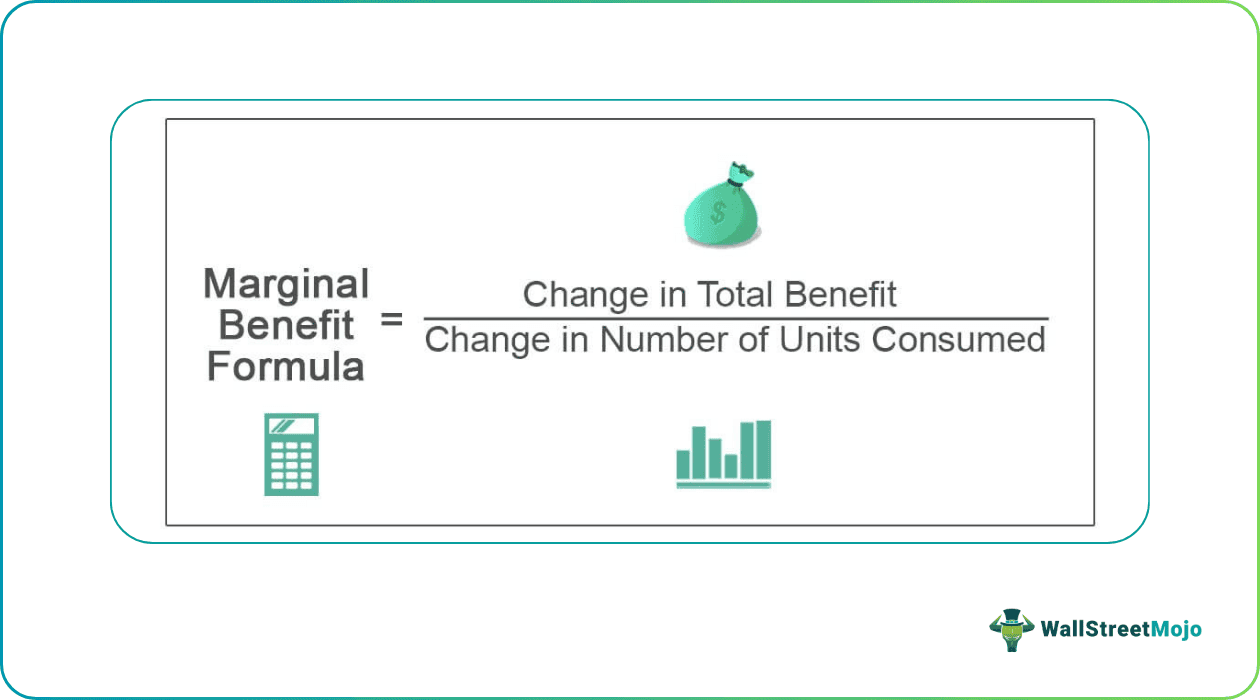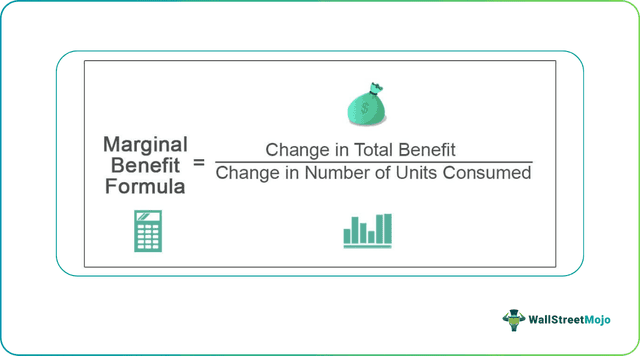Table Of Contents
Marginal Benefit Meaning
The marginal benefit helps an organization determine the optimal level of benefit derived from consumption and calculates the estimated quantity of its product/ service demanded by the market, thereby increasing cost efficiency in running a business. In short, it helps an organization to run its business more efficiently. Based on the optimal level of benefit, an organization may prepare the budget for the quantity to be produced.

Marginal benefit is the progressive increase in favor of a consumer due to increased consumption by an extra unit of product or service purchased. However, consumer satisfaction tends to decrease as consumption increases. The change in the number of benefits the customer derives by increasing consumption by one additional unit of goods/ service is a marginal benefit equation.
Marginal Benefit Explained
Marginal benefit, a pivotal concept in economics and finance, refers to the additional or incremental advantage or satisfaction that an individual or entity derives from consuming or investing in one more unit of a particular resource, product, or activity. Here's a more in-depth exploration of this concept:
Marginal benefit plays a fundamental role in incremental decision-making. It guides individuals and businesses in assessing whether the additional utility gained from consuming or investing more is worth the associated costs.
A core principle associated with marginal benefit is the law of diminishing marginal utility. This law posits that as one consumes or invests more of a resource, the additional benefit derived from each subsequent unit tends to decrease. In other words, the first unit of a good or service typically provides the greatest marginal benefit, with diminishing returns as consumption or investment increases.
Rational decision-makers weigh the marginal benefit against the marginal cost (the additional cost of consuming or investing in one more unit) to determine whether it's worthwhile. If the marginal benefit exceeds the marginal cost, it's generally advisable to proceed.
In finance, marginal benefit cost informs investment decisions. For example, an investor might evaluate the marginal benefit of adding another stock to their portfolio by considering how it contributes to diversification, potential returns, and risk reduction.
Marginal benefit also ties into the concept of utility maximization. Economists often assume that individuals seek to maximize their overall satisfaction or utility by consuming or investing in goods and services up to the point where the marginal benefit equals the marginal cost.
Understanding marginal benefit is vital for making informed financial choices, as it enables individuals and businesses to optimize their resource allocation, balance their portfolios, and make rational decisions that align with their goals and preferences.
Formula
Let us understand the formula that shall act as a basis for our understanding of the marginal benefit equation through the discussion below.
Marginal Benefit Formula = Change in Total Benefit / Change in Number of Units Consumed
Change in Total Benefits
This part comprises the change in total benefit and is derived by deducting the overall benefit of the current consumption from previous consumption. Let us develop a better understanding with the help of the following example. Say by consuming the first banana, a consumer gains a benefit of 10 units, whereas the second banana leads to the total benefit of 18. To arrive at the change in total benefit between the second and first banana, we need to deduct the total benefit of the first banana from the second banana. The result is a total Benefit of 8 (18 – 10).
Change in Number of Units Consumed
This part comprises calculating the change in the number of units consumed. It is derived by deducting the amount of the unit that is currently being consumed from a previously consumed unit. For example, the change in units consumed from the second and first banana is 1 (2 – 1).
When both parts are calculated, the marginal benefit is derived by dividing the change in total benefit by the difference in the number of units consumed.
Examples
Now that we understand the basics and formula of marginal benefit cost, let us understand how to apply it to practical application through the examples below.
Example #1
Suppose a consumer, Harry buys and consumes an ice cream; let the benefit derived from the ice cream be measured as 50 units. Then, Harry consumes another three ice creams. The benefit derived from 2nd, 3rd, and 4th ice cream is 40, 35, and 25. Calculate the marginal benefit for 1st & 2nd and 1st & 3rd units of Ice cream.
Solution:
Use the given data for the calculation

The calculation for 1st and 2nd Ice Cream can be done as follows:

1st and 2nd ice cream is (50-40) / (2nd – 1st unit)

Marginal Benefit for 1st and 2nd Ice Cream = 10
The calculation for 3rd and 1st Ice Cream can be done as follows:

Benefit for 3rd and 1st ice cream is (50 – 35) / (3rd – 1st unit)
Benefit for 3rd and 1st Ice Cream will be -

Marginal Benefit for 3rd and 1st Ice Cream = 7.5
Example #2
Mr. Peter runs a business selling tea. Based on past selling experience, he has estimated benefits derived from consuming his tea mentioned as follows:
| Quantity of Tea | Total Utility |
|---|---|
| 1 | 300 |
| 2 | 540 |
| 3 | 670 |
| 4 | 780 |
| 5 | 880 |
You are required to calculate marginal benefit for each extra unit sold.
Solution:

Marginal Benefit for Quantity of Tea One = (300-0)/(1-0)

Similarly, we can calculate the marginal benefit for the remaining quantity of tea.

Example #3
Let’s say Mr. Harry sells ice cream at $10 each. The variable cost of making is $5 per unit. This leaves a gross profit of $5 per unit. (Fixed cost ignored for simplicity).
- Current Gross Profit: 720
- Previous Gross Profit: 500
- Current Sales Volume: 180
- Previous Sales Volume: 100
On a Sunday, he sells 100 units leading to a gross profit of $5 x 100 units or $500.
But to increase sales, Harry decides to lower the price to $9 each. So you would make a gross profit of $4 per unit at this price.
Due to the reduced prices, sales volume increased to 180 units. The first 100 consumers agreed to pay $10, so they’re even happier to pay $9. Further, 75 more customers joined and are willing to pay $9. The gross profit is now 720.
The calculation can be done as follows:

The marginal benefit will be ($720-$500)/(180 units – 100 units)

The final sales price may be calculated by the seller based on different factors affecting its business.
Marginal Benefit Vs Marginal Cost
Let us understand the differences between marginal benefit equation and marginal cost through the comparison below.
Marginal Benefit
- Refers to the additional utility or satisfaction gained from consuming or investing in one more unit of a resource or activity.
- It helps individuals and businesses assess the value of incremental decisions.
- Diminishes with each additional unit, following the law of diminishing marginal utility.
- Guides rational decision-making by comparing the added benefit with the associated costs.
- In finance, marginal benefit aids investors in evaluating the potential gains from additional investments or portfolio adjustments.
Marginal Cost
- Represents the additional cost incurred when consuming or investing in one more unit of a resource or activity.
- It can include monetary expenses, time, effort, or any resources sacrificed.
- Generally, rises as more units are consumed or invested, reflecting the law of increasing marginal cost.
- Rational decision-makers consider MC alongside MB to determine whether an action is cost-effective.
- In financial contexts, marginal cost helps investors assess the cost implications of portfolio changes or investment decisions.


